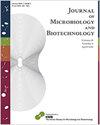Bacterial Community of Breast Milk in Breastfeeding Women Using CultureDependent and Culture-Independent Approaches.
IF 3.1
4区 生物学
Q3 BIOTECHNOLOGY & APPLIED MICROBIOLOGY
引用次数: 0
Abstract
This study aimed to analyze bacterial communities in breast milk obtained from five breastfeeding women. Culture-dependent and culture-independent methods were used to analyze microbial communities. Total bacterial count of breast milk determined using plate count agar ranged from 3.3 × 104 ± 3.5 × 102 colony forming unit (CFU)/g to 1.7 × 105 ± 3.5 × 103 CFU/g, with a pH between 6.4 and 6.8. Only three species, Leuconostoc citreum (17 out of 160 strains; 10.63%), Staphylococcus epidermidis (118 strains; 73.75%), and Staphylococcus lugdunensis (25 strains; 15.63%), belong to the phylum Bacillota were detected by culture-dependent analysis. Microbial communities analyzed via pyrosequencing revealed greater diversity compared to the culture-dependent analysis. At the phylum level, Bacillota accounted for 60.9% of the microbial community. At the genus level, Staphylococcus (24.57%), Streptococcus (22.93%), and Methylobacterium (8.76%) were dominant genera. While pyrosequencing demonstrated greater microbial diversity than the agar plate culture method, identified microbes might lack information or include many unculturable microbes. Most of all, considering the low total bacterial count averaging 7.2 × 104 CFU/g, further research is needed to determine the significance of microbial presence in breast milk.用培养依赖型和培养独立型方法分析哺乳期妇女母乳中的细菌群落。
本研究旨在分析五名哺乳期妇女母乳中的细菌群落。研究采用培养依赖法和培养非依赖法分析微生物群落。使用平板计数琼脂测定的母乳细菌总数从 3.3 × 104 ± 3.5 × 102 菌落总数(CFU)/克到 1.7 × 105 ± 3.5 × 103 菌落总数(CFU)/克不等,pH 值介于 6.4 和 6.8 之间。通过培养分析,只检测到三个属于芽孢杆菌门的菌种:柠檬白念珠菌(160 株中有 17 株,占 10.63%)、表皮葡萄球菌(118 株,占 73.75%)和卢格敦葡萄球菌(25 株,占 15.63%)。与依赖培养物的分析相比,通过热测序分析的微生物群落显示出更大的多样性。在门一级,芽孢杆菌占微生物群落的 60.9%。在属一级,葡萄球菌(24.57%)、链球菌(22.93%)和甲基杆菌(8.76%)是优势菌属。虽然高温测序法比琼脂平板培养法显示出更高的微生物多样性,但鉴定出的微生物可能缺乏信息或包括许多无法培养的微生物。最重要的是,考虑到细菌总数较低,平均为 7.2 × 104 CFU/g,因此需要进一步研究,以确定母乳中微生物存在的意义。
本文章由计算机程序翻译,如有差异,请以英文原文为准。
求助全文
约1分钟内获得全文
求助全文
来源期刊

Journal of microbiology and biotechnology
BIOTECHNOLOGY & APPLIED MICROBIOLOGY-MICROBIOLOGY
CiteScore
5.50
自引率
3.60%
发文量
151
审稿时长
2 months
期刊介绍:
The Journal of Microbiology and Biotechnology (JMB) is a monthly international journal devoted to the advancement and dissemination of scientific knowledge pertaining to microbiology, biotechnology, and related academic disciplines. It covers various scientific and technological aspects of Molecular and Cellular Microbiology, Environmental Microbiology and Biotechnology, Food Biotechnology, and Biotechnology and Bioengineering (subcategories are listed below). Launched in March 1991, the JMB is published by the Korean Society for Microbiology and Biotechnology (KMB) and distributed worldwide.
 求助内容:
求助内容: 应助结果提醒方式:
应助结果提醒方式:


